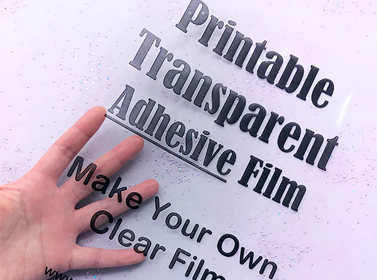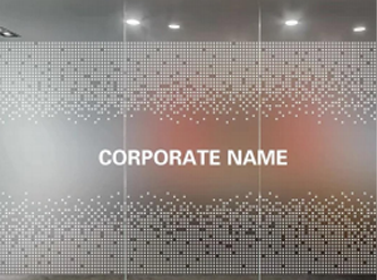How to Solve the Problem of Raised Edges in Self-adhesive Adhesive Film for Advertising
Self adhesive backing film is one of the most widely used materials in the advertising and signage industry. It has the advantages of multifunctionality and moderate cost, and is suitable for various scenarios such as outdoor billboards, indoor promotional displays, window displays, vehicle advertising, and exhibition backgrounds. However, one of the most common issues during installation and use is edge curling – that is, the edges of the film come off, curl, or curl. This not only affects the aesthetics of the advertising image, but also shortens the service life of the film, resulting in additional time and cost waste.
Table of Contents
ToggleThis article will comprehensively analyze the causes, prevention methods, and detailed repair steps of edge curling in self-adhesive adhesive films. At the same time, we will also provide professional installation techniques, substrate treatment methods, adhesive selection suggestions, and key maintenance points in the later stage. Through this complete guide, you will be able to effectively avoid and solve the problem of curled edges, making advertising display more sustainable and stable.
What is the Phenomenon of Film Edge Curling?
Definition
Bent edge refers to the detachment, curling, or curling of the edge of the film on the adhesive surface. This situation may occur shortly after installation or gradually over time. In advertising display applications, curled edges can cause the following problems:
Affects the overall aesthetics and professionalism of advertising.
Shorten the lifespan of the film.
Make it easier for dust, water vapor, ultraviolet rays, etc. to penetrate and exacerbate damage
Decreased customer experience, even affecting brand image.

Common Reasons
- Film curling is usually caused by improper installation or external environmental factors. The main reasons include:
- Residual dust, oil stains, or moisture on the surface can reduce the stickiness of the adhesive.
- Coarse, porous, or low surface energy substrates (such as partially plastic or textured walls) are more prone to edge detachment.
- When installed in extreme high or low temperature environments, the adhesive performance of the glue will be reduced.
- Insufficient pressure or excessive stretching of the film during installation can increase the risk of edge curling.
- Low price and low-quality film or inferior glue are prone to failure.
- Edges such as car doors, glass corners, and sharp angles are more prone to warping.
How to Prevent Film Curling Edges
Prevention is the best way to solve the problem of curled edges. Here are some key installation points:
1.Substrate treatment
Thoroughly clean the substrate using a lint free cloth combined with a mild cleaning agent or isopropanol.
Remove impurities such as oil stains, dust, silicone oil residue, wax, etc.
Ensure that the substrate is completely dry.
2.Choose the appropriate film
Select different types of adhesive based on the application scenario (permanent adhesive for outdoor advertising, removable adhesive for short-term indoor display).
Choose high viscosity film for difficult to stick surfaces.
3.Temperature control
The optimal construction temperature is between 15 ° C and 30 ° C.
Avoid installing in environments that are too cold or too hot.
4.Use professional tools
Use a scraper with a felt edge to apply even pressure.
For curved or textured surfaces, it can be heated with a hot air gun to enhance adhesion.
5.Edge sealing
Use edge sealant in high stress applications such as car stickers or outdoor advertising.
Film or protective film can also be used to enhance durability.
6.Avoid excessive stretching
The stretching amplitude should not exceed 10%, otherwise it is easy to generate stress and cause curling.
7.Hand over the installation to professional personnel
Large scale advertisements (such as car body stickers and billboards) are recommended to be operated by experienced construction personnel.

How to fix curled edges: step-by-step guide
If the film has curled edges, it can be repaired by the following steps:
1: Check the Range of Curled Edges
Determine whether it is local edge curling or large-scale detachment.
If more than 50% of the film is lifted, it is recommended to replace it directly.
2: Clean the Curled Edge Area
Clean the raised edges and substrate surface with isopropanol.
Remove dust and adhesive residue.
3: Add Glue (if necessary)
Small areas can be repaired with specialized film adhesive or double-sided tape.
Spray glue can be used on a large scale, but it must be compatible with the film.
4: Heating Softening
Use a heat gun to slightly heat the raised part.
Be careful not to overheat to avoid damaging the film or printed pattern.
5: Re Compact
Use a scraper to apply pressure from the edge outward and expel the bubbles.
Ensure even force distribution.
6: Edge Sealing
Use edge sealant to prevent the edges from curling again.
Temporary processing can use transparent tape to seal the edges.
7: Post Maintenance
Regular inspections, especially for outdoor applications.
Apply sealant if necessary.
Professional skills and maintenance suggestions
Choose High Quality Film
High quality film not only has clearer visual effects and fuller colors, but also its adhesive layer’s stability, weather resistance, and tensile strength are far superior to low-priced inferior products. Choosing the self-adhesive advertising film produced by Shandong Chengji New Materials can effectively reduce the incidence of problems such as warping, cracking, and fading. In the long run, the maintenance cost reduction brought by high-quality materials is far more valuable than one-time cost savings.
Film Protection
For long-term outdoor displays or advertising veneers that require frequent friction, it is recommended to cover the surface with a transparent protective film. Covering film not only increases the thickness and hardness of the film, but also resists ultraviolet radiation, prevents pattern fading, and reduces dust and stain adhesion. Especially in car body advertising and floor mounted advertising, film covering can significantly extend the service life and keep the image bright and new.
Regular Cleaning
After the installation of the film, it does not mean that it can be left unattended for a long time. It is recommended to clean regularly to maintain a smooth surface. When cleaning, a mild neutral cleaner and a soft cloth or sponge should be used to gently wipe the surface, avoiding strong scratching or using a hard bristled brush. Regular cleaning can not only extend the service life, but also maintain the visual impact and brand image of advertising images.
Avoid Chemical Corrosion
Chemical substances such as strong solvents, concentrated alcohol, and abrasive cleaners can easily corrode the surface of the film or damage the structure of the adhesive layer, leading to edge curling, fading, or brittle cracking. Therefore, the use of such cleaning agents should be avoided during daily maintenance. For vehicle advertising, users should be reminded to avoid contact with cleaning solutions containing strong solvents at gas stations or repair workshops.
Conclusion
Although the problem of curling edges in self-adhesive adhesive film is common, it can be completely solved through reasonable prevention and correct repair. Mastering techniques such as substrate cleaning, material selection, construction temperature, pressure control, and edge sealing can significantly reduce risks. Once the edge curling problem occurs, the service life can also be extended through methods such as heating, gluing, re compaction, and sealing.
For advertising companies, avoiding film warping not only saves costs, but also enhances customer satisfaction and brand professionalism.









